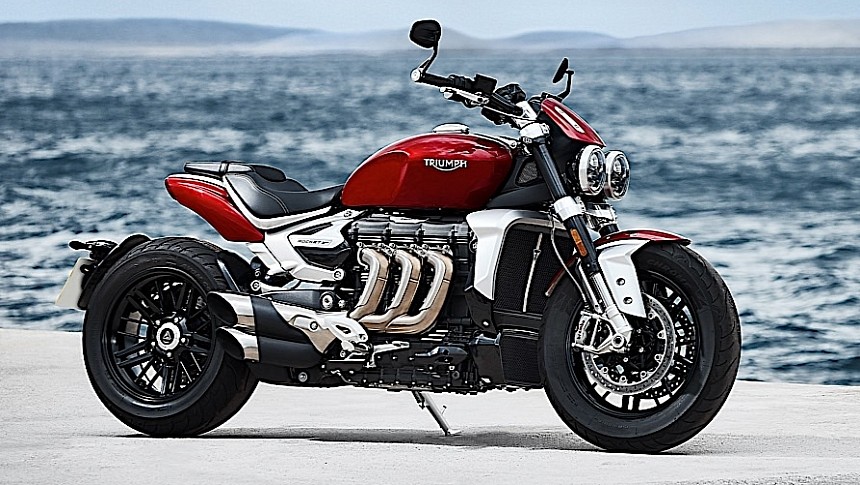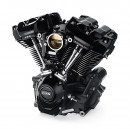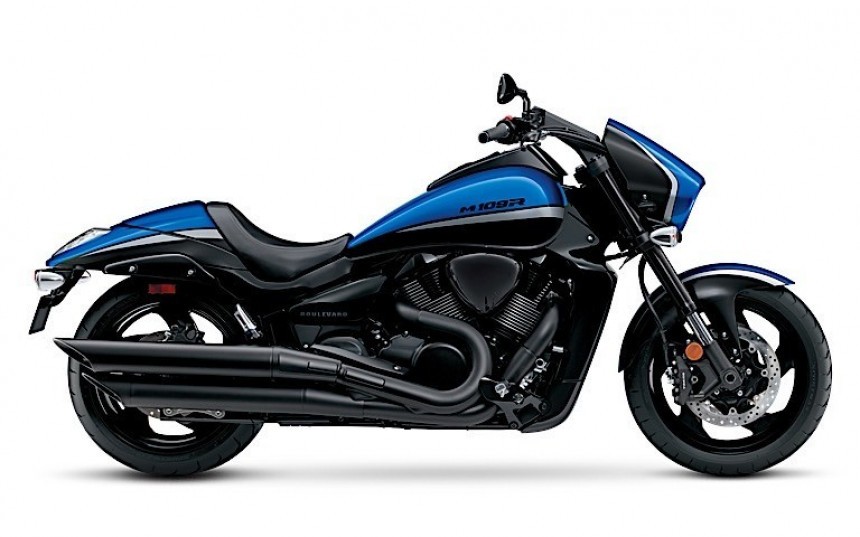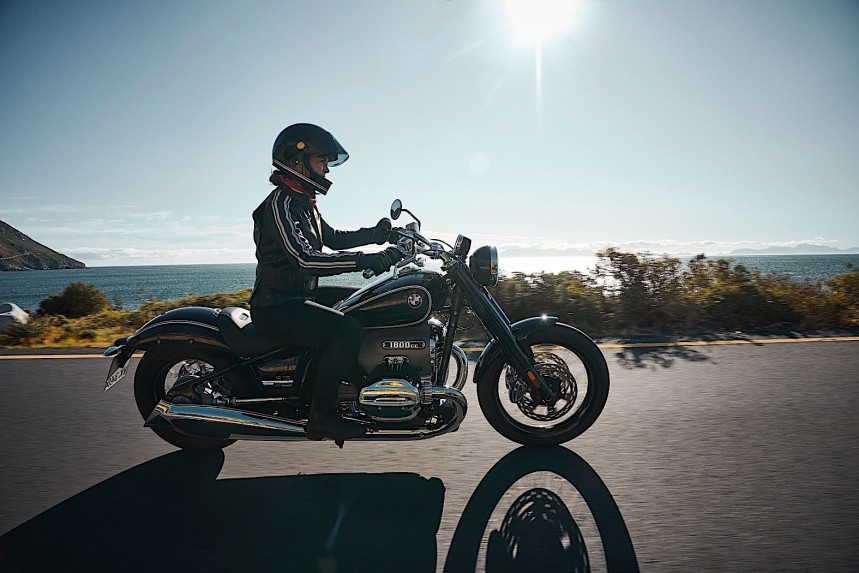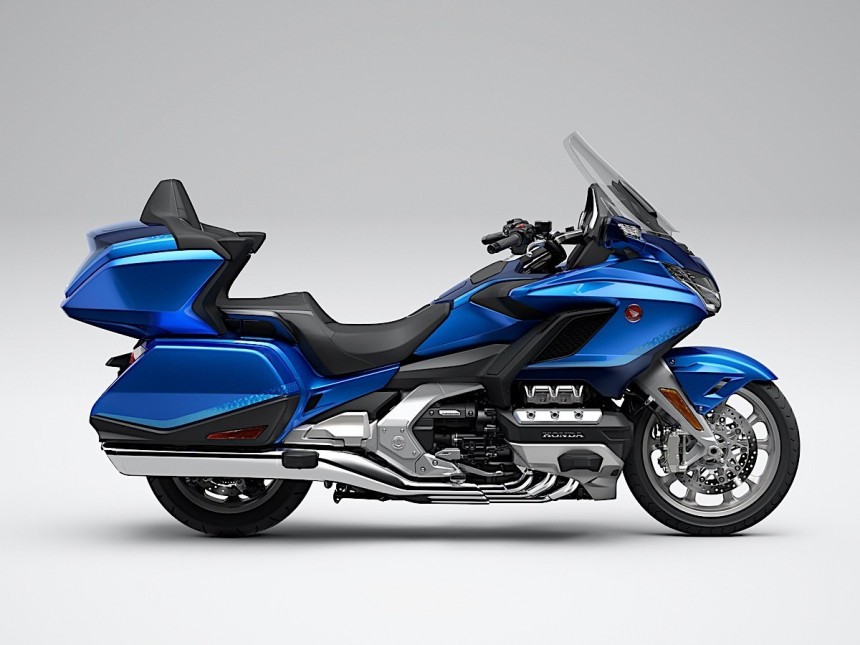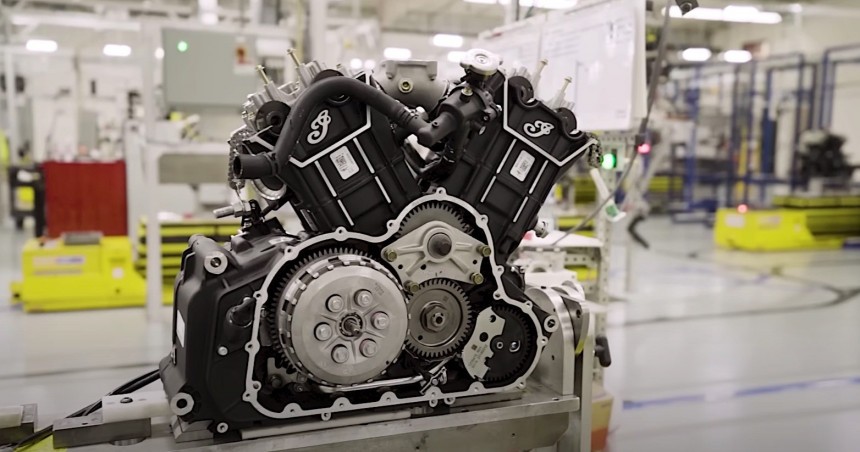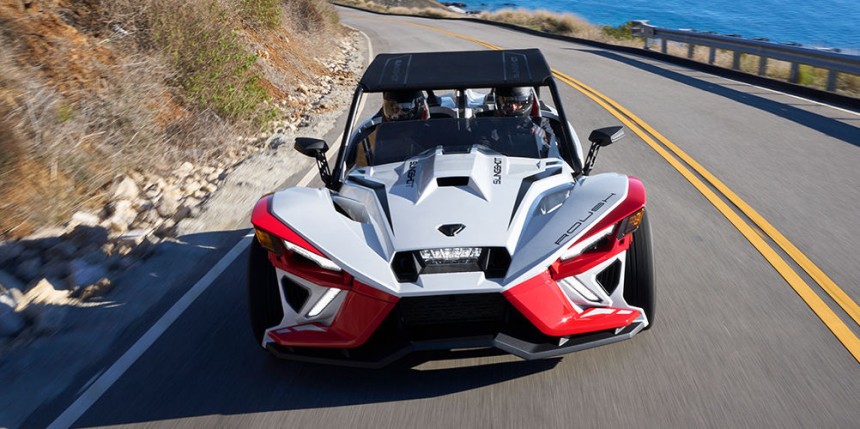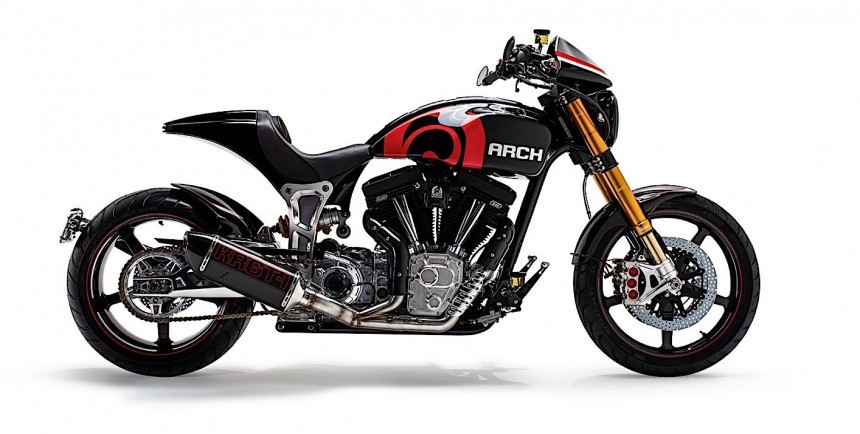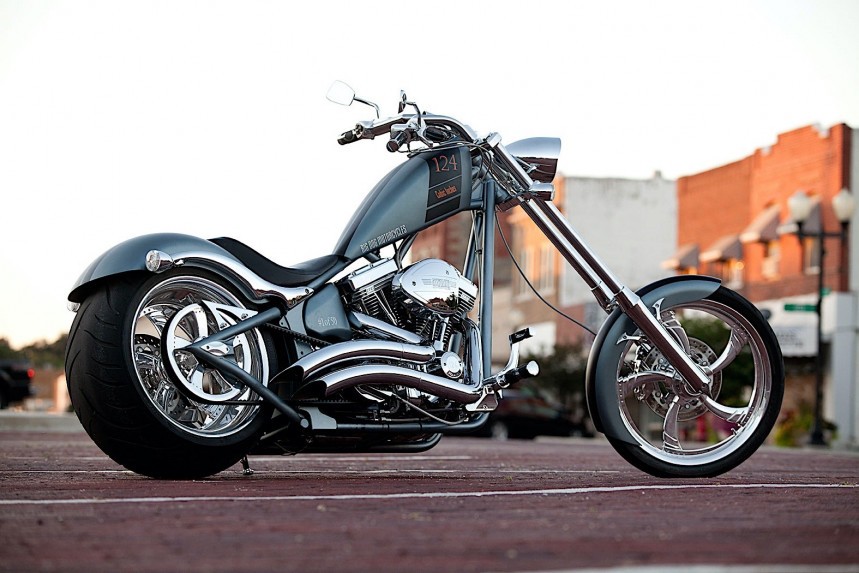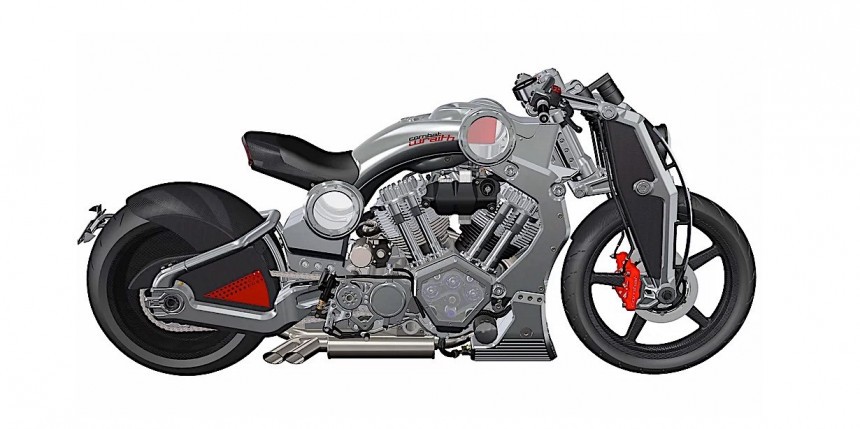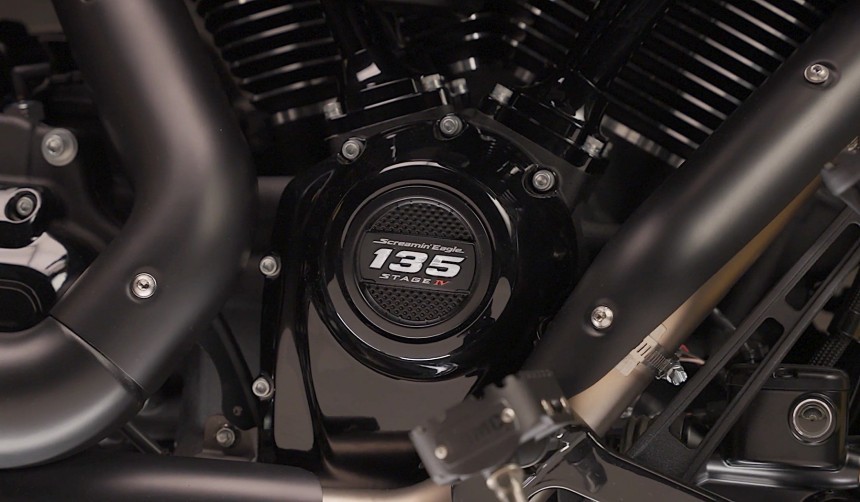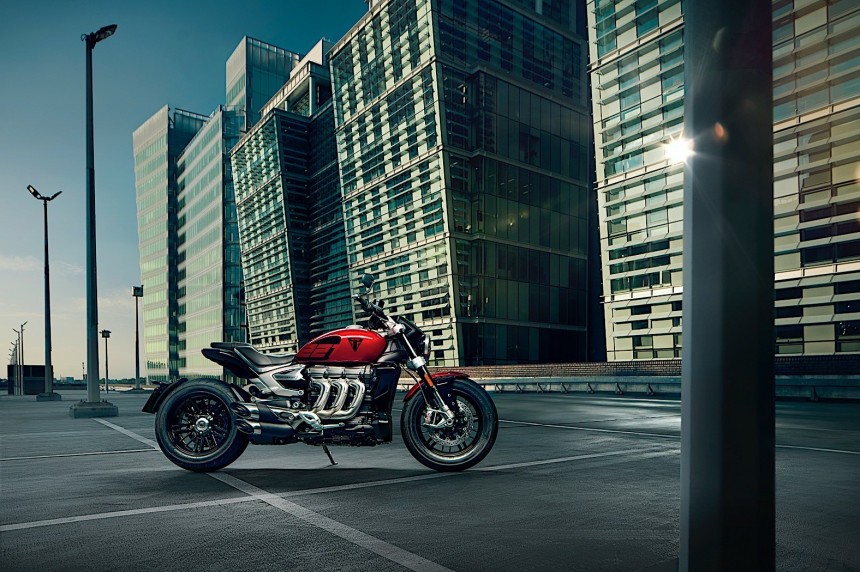One way of looking at how vehicles are made today is to consider cars habitats on wheels, while motorcycles are, of course, nothing more than engines on wheels. And it's those engines, the biggest of them currently available, that we're here to discuss today.
Motorcycle engines presently come in a variety of shapes, sizes, and configurations, but they all share a common ancestor: the 264cc (16ci) diesel powerplant two Germans by the name Gottlieb Daimler and Wilhelm Maybach fitted on a wooden bicycle all the way back in 1885.
Called throughout history the Reitwagen, that contraption opened the door to an entire universe of possibilities in the world of two-wheeled mobility. A universe that presently manifests itself in the form of parallel twins, V-twins, four cylinders, boxers, and more recently even electric drives.
Whereas the various types of motorcycle engines are a topic interesting enough to warrant its own dedicated story, this time we'll try to dive deep into the size of these things by telling you a thing or two about 2023's largest displacement production bikes. Because yes, size does matter.
Before getting into it, I'll remind you engine displacement for motorcycles is all over the place, generally ranging from the 50cc we usually get on mopeds and the likes to powerplants so large they'll likely feel a lot better under the hood of the car.
What engine size goes into what motorcycle depends greatly on what the bike maker wants to accomplish. For rides dedicated to beginners or city riding, engines of up to 600cc are more than enough. For racing, companies go for sizes of around 1,000cc, while touring machines are literally born to double that.
Just like what happens in the car world, the bigger the engine the more powerful and faster the bike. On the downside, larger engines also mean more weight for the motorcycle. That in turn translates into somewhat more complicated handling that requires more experience.
In a nutshell, motorcycles with big displacement engines are not meant to be ridden by beginners. But they too can enjoy their incredible specs, so let's dive right into it.
It must take a lot of confidence for a bike maker to name one of its products BOSS. Sure, in the case of Suzuki the acronym is meant to represent a contraction of the phrase Blacked Out Special Suzuki, but it's obvious to anyone the Japanese have smartly played the word game here.
B.O.S.S. is an appendix slapped on one of the best cruisers presently available on the market, a variant of the Boulevard also called M109R. That 109 number caught in between the two consonants is where the secret to this incredibly successful bike resides.
That's because it's meant to represent the number of cubic inches the thing's engine displaces. In cubic centimeters, that would be 1,786, which is about as much as many of the cars presently being sold in Europe clock in.
The engine on this Boulevard, which first came into existence in 2006, is a V-twin, but one the likes of which one rarely comes across. Made of forged aluminum, the engine's pistons measure a staggering 4.4 inches (112 mm), making them some of the largest in both the moto and the auto industries.
This little detail allows the bike to be a true monster when it comes to rpm and torque. The numbers that matter here are 128, which stands for horsepower, and 118 lb-ft, which stands for torque, and allows for almost instant acceleration.
Despite all the craziness of the engine, the bike is not at all prohibitively expensive. Keeping true to the creed cruisers should be affordable, Suzuki slapped on the thing a sticker that reads just $15,299.
BMW Motorrad is one of the biggest motorcycle makers on the planet, and as such it plays the game in many segments of the industry. Yet for a long time it was almost absent from the cruiser market.
Between 1997 and 2004 BMW produced a bike called R1200C, one it launched with great fanfare by managing to have it featured in the Tomorrow Never Dies James Bond movie. Despite this, and despite the many things the bike had going for it, it was pulled from production after just around 40,000 of them were made.
From 2004 to 2020 the German company lacked a presence in the cruiser segment. Then, seeing Harley-Davidson's loosening grip on buyers, it launched the R 18.
A cruiser true and true, the model has grown in the three years that have passed since to include no less than six models, starting with the main one, going through several special editions, and ending with the mighty R 18 Transcontinental. And they all have one very important thing in common: they are powered by the "most powerful 2-cylinder boxer engine ever used in motorcycle series production," and at the same time the highest displacement boxer engine the Germans have ever made.
Fitting a 1,802cc (110ci) monster on a cruiser motorcycle with obvious touring capabilities makes perfect sense, as such a piece of hardware needs to be powerful enough to get the job done. In numbers, that would be 91 horsepower at 4,750 rpm, and torque levels sitting at 116 lbs-ft at 3,000 rpm.
Such capabilities and size usually do not come cheap, but that's not really the case here. The least amount of money one can hope to spend to get their hands on an R 18 is $14,995 for the simple R 18. The Transcontinental, on the other hand, easily jumps over $20k.
Honda's Gold Wing is one of the most important motorcycles on the market. It was born from the get-go in the 1970s to be the King of Kings, perhaps the ruler of all bikes sold in America, but certainly a notch above what Harley-Davidson had to offer at the time.
Playing the game in the touring segment, where big displacement engines are not only something to be desired, but a must, the Gold Wing was just confirmed back in October to continue into the 2024 model year, leaving us with yet another large displacement bike on our hands.
That is not supposed to mean that during its long life Honda's flagship model didn't experiment with smaller powerplants. The first one made in the 1970s, for instance, had a unit that displaced just 999cc (61ci). That later grew to 1,470cc (90ci), and as more and more elements were fitted onto the bike to make it a proper touring, it eventually reached today's 1,833cc (112ci).
The unit is of the liquid-cooled variety, with a horizontally opposed six-cylinder layout and four strokes of coolness. At its finest, the unit cranks out 125 horsepower at 5,500 rpm and 170 Nm of torque at 1,000 rpm lower than that.
No less than five versions of the Gold Wing are presently on the market, all with the same powerplant in the frame. Prices range from $24,700 for the simple version to $33,000 for the Tour variant with a DCT automatic transmission.
Although born at about the same time as Harley-Davidson and together with its rival one of just two legacy bike makers to have survived the Great Depression, Indian Motorcycles didn't actually make any motorcycles and engines for a large part of its existence.
Between 1953 and 2010 the name was just a shadow of its former self, selling under different ownership a variety of products made by others. Then, in 2011, Polaris stepped in and Indian was finally reborn.
The new company quickly got to work, and in 2013 it released its first motorcycle engine of the modern era, part of a family that would become known as the Thunderstroke. The family started out timidly, with units displacing just 111ci (1,819cc), but quickly moved up the ranks so that now the bike maker cannot be ignored on a list of largest motorcycle engines such as ours.
The largest Indian engine one can get their hands on these days is the Thunderstroke which displaces 116ci (1,900cc). It is the powerplant fitted in the frames of the bike maker's most potent motorcycles, the big boys of the lineup like the Springfield, Chieftain, and Roadmaster.
That's quite the selection of rides, playing in most of the industry's segments, at least price-wise, appealing to a very large pool of customers. The Chieftain, for instance, retails from $23,999, while the Roadmasters starts at $32,999, making for a very solid offering of two-wheelers.
I know, you're probably scratching your head at this one. How is the Polaris Slingshot, given it has three wheels, two seats, a steering wheel, and in certain configurations a cockpit shielded from the weather by a roof a motorcycle? The simple answer is this: Polaris calls all its three-wheelers motorcycles, and the Slingshot is no exception.
Perhaps the weirdest and at the same time most interesting item on our list was born back in 2014 as a blend between the front end of a car, complete with a two-seater configuration, and the rear end of a motorcycle. It was successful enough for it to be kept in production from then and well into our time. Why, it even received special editions.
Partially responsible for the reverse trike's success is the engine it packs under the hood (yes, it has a hood). The powerplant is a Polaris unit from the Prostar family, the same one that's used on the company's snowmobiles.
The same engine is used across all five variants of the Slingshot. We're talking about a 122ci (1,997cc) piece of hardware in a four-cylinder configuration that plays the game in the 200+ horsepower class (and 144 ft-lbs of torque on top of that), and it plays it well.
Despite the large engine for a motorcycle, and the immense power it develops, the Slingshot is not allowed to go over 125 mph (201 kph).
The Roush Edition of the trike brings no actual upgrades to the powerplant, but does add a few visual, comfort, and equipment cues that make it quite special. So special, in fact, Polaris is asking at the time of writing $38,149 for one, more than $16,000 for the entry-level version of the Slingshot.
If you been watching our coverage of the best things the motorcycle industry has to offer, then you've probably noticed no matter what the topic is, several non-legacy motorcycle companies and startups are included. Not here, though, as there's only one, and even in this case, the startup is not itself responsible for the engine.
The reason for that is simple enough. All young moto companies either tend to stay away from large displacement engines, as they're more complicated and expensive to make, or choose to go down the electric motorcycle path.
It does happen for some of them to break the norm, though, and the Keanu Reeves-backed Arch is one of them. With a lineup of just two models on the table, the company is making some real waves among people in the market for a bespoke ride.
The two bikes Arch is making are the 1S and the KRGT-1 (Keanu Reeves GT-1, get it?), both of which use the same S&S-sourced 124ci (2,032 cc) engine. The unit, which can be found on many full custom motorcycles, is a fuel-injected V-twin capable of developing 122 horsepower and 122 Nm of torque.
The engine and the frame are probably the only things Arch customers are forced to accept, as everything else is made to specification. As such, there is no fixed price for the bikes, but each of them can easily go past the $100,000 mark.
Now the powerplant on this one may be the same size in terms of engine displacement as the Arch bikes, but we are talking about two entirely different approaches to bike building.
In the case of the S&S Sidewinder 45-degree V-twin engine, power and torque are sent through a 6-speed transmission to move about a chopper-style cruiser motorcycle the likes of which you'll see nowhere else in production form.
Unlike most of the other powerplants that come with the bikes listed here, the Super Sidewinder can only be had as a fuel-injected piece, but also carbureted, for the sake of old-school thrills.
A quick look at this bike and the specs sheet that accompanies it (which also includes things like a custom frame, a swingarm, hidden adjustable rear shocks, and Avon tires pulled over the custom wheels) would have you believe the K9 is one expensive ride.
Far from it, as this production version custom motorcycle can be had for as little as $39,995. Granted, that's not exactly Fat Boy territory, but it's also not nearly as expensive as what comes next (read on if you dare).
The Wraith is one of those motorcycle designs that are impossible to ignore. That's not only because it is made by a company known for its extreme take on two-wheelers, but also because its products, although in series production, are so rare that they're borderline gems.
Tracing its roots back to another company called Confederate Motors, Combat is presently making four bike models, namely the F-117 Fighter, P-51 Fighter, Bomber, and Wraith. All of them are very capable machines, but we've chosen the Wraith because, well, it's the only one still listed as available, with the other ones on the market sold out.
Climbing on the back of the Wraith must feel like nothing in the motorcycle world, not in small part thanks to the all-metal look of the ride that makes it look like it was just assembled from many matching parts, like a metal LEGO.
Perfectly visible to the naked eye is the 132ci S&S X-Wedge engine sitting in the frame, a powerplant punchy enough to return 143 hp and 160 ft-lb of torque.
If not for other considerations, the appearance and potential of the X-Wedge seem like the perfect choice for a motorcycle that may very well be the most expensive you'll read about here: $155,000.
120 years of existence means a very long time no matter what we're referring to, but the number kind of takes a certain meaning when talking about a company. After all, if it lasted that long, it must be good.
That's exactly how old Harley-Davidson got in 2023, and it celebrated its birthday through some very remarkable releases. The most remarkable of all, if you ask me, is the newest version of the Screamin' Eagle crate engine.
As you all know, Harley's history as an engine maker is very rich, and over the years the brand has been responsible for some very iconic powerplants coming into existence. Most of them were fitted right from the factory floor on motorcycles, but there is this Screamin' Eagle that is only offered as an aftermarket upgrade.
Earlier this year the bike maker introduced the crate engine with the largest displacement it has ever made, something that's officially called Screamin' Eagle 135 Stage IV. And no, you're not wrong; the 135 written there is meant to represent the displacement in cubic inches. Which is exactly 2,212cc.
The monster of an engine is, naturally, a V-twin, capable thanks to its immense size of developing 130 horsepower at 5,500 rpm and 143 lb.-ft. at 3,500 rpm. For comparison's sake, I'll remind you that's 41 percent more hp and 28 percent more torque then the most potent of Milwaukee-Eight engines, the 117 we usually get in the Glides and the Road King.
The Screamin' Eagle 135 was released by Harley as a potential replacement for the engines fitted from the factory floor in the Touring lineup of motorcycles. It's a bolt-on piece that requires a price of $7,999.95 to be paid, not including the head pipes and oil coolers, among other things.
Impressive as all of the above engines are, at least in terms of displacement, they don't come even close to the powerplant installed in the frame of a motorcycle called Rocket 3. Made by Triumph, it can be seen as the engine size overkill of the motorcycle industry.
Triumph first started the Rocket 3 back in 2004, and it hid all its secrets in the name. Rocket is there because, well, the thing is meant to be a rocket on wheels, and the 3 represents the number of cylinders in the engine.
But there is one thing the British bike maker left out of the model's name, and that's the displacement of the engine. And seeing how this is, for all intents and purposes, the motorcycle with the biggest engine currently in production, maybe that bit of info should have been included there.
It's not entirely clear why Triumph decided to build the largest bike engine in the world and offer it on a production two-wheeler, as there are only marginal advantages coming from this size over smaller units.
Other than the fact it allows the British brand to boast not only with size, it also does this for the highest torque figure of any production engine, 163 lb-ft. Peak power, on the other hand, is probably not all it could be for an engine this big, stopping at 164 hp at 6,000 rpm. That's a lot judging by the standards of this list, but not truly impressive, considering there are many bikes out there capable of more from less.
Nevertheless, the monster on two wheels that is the Rocket is here, and it is selling in no less than six variants. The cheapest one goes for $23,895, which is not all that much, all things considered.
Called throughout history the Reitwagen, that contraption opened the door to an entire universe of possibilities in the world of two-wheeled mobility. A universe that presently manifests itself in the form of parallel twins, V-twins, four cylinders, boxers, and more recently even electric drives.
Whereas the various types of motorcycle engines are a topic interesting enough to warrant its own dedicated story, this time we'll try to dive deep into the size of these things by telling you a thing or two about 2023's largest displacement production bikes. Because yes, size does matter.
Before getting into it, I'll remind you engine displacement for motorcycles is all over the place, generally ranging from the 50cc we usually get on mopeds and the likes to powerplants so large they'll likely feel a lot better under the hood of the car.
What engine size goes into what motorcycle depends greatly on what the bike maker wants to accomplish. For rides dedicated to beginners or city riding, engines of up to 600cc are more than enough. For racing, companies go for sizes of around 1,000cc, while touring machines are literally born to double that.
Just like what happens in the car world, the bigger the engine the more powerful and faster the bike. On the downside, larger engines also mean more weight for the motorcycle. That in turn translates into somewhat more complicated handling that requires more experience.
In a nutshell, motorcycles with big displacement engines are not meant to be ridden by beginners. But they too can enjoy their incredible specs, so let's dive right into it.
10. The engine with the largest pistons on the Suzuki Boulevard M109R B.O.S.S. (109ci/1,783cc)
B.O.S.S. is an appendix slapped on one of the best cruisers presently available on the market, a variant of the Boulevard also called M109R. That 109 number caught in between the two consonants is where the secret to this incredibly successful bike resides.
That's because it's meant to represent the number of cubic inches the thing's engine displaces. In cubic centimeters, that would be 1,786, which is about as much as many of the cars presently being sold in Europe clock in.
The engine on this Boulevard, which first came into existence in 2006, is a V-twin, but one the likes of which one rarely comes across. Made of forged aluminum, the engine's pistons measure a staggering 4.4 inches (112 mm), making them some of the largest in both the moto and the auto industries.
This little detail allows the bike to be a true monster when it comes to rpm and torque. The numbers that matter here are 128, which stands for horsepower, and 118 lb-ft, which stands for torque, and allows for almost instant acceleration.
Despite all the craziness of the engine, the bike is not at all prohibitively expensive. Keeping true to the creed cruisers should be affordable, Suzuki slapped on the thing a sticker that reads just $15,299.
9. The most powerful 2-cylinder boxer engine ever on the BMW R 18 (110ci/1,802cc)
Between 1997 and 2004 BMW produced a bike called R1200C, one it launched with great fanfare by managing to have it featured in the Tomorrow Never Dies James Bond movie. Despite this, and despite the many things the bike had going for it, it was pulled from production after just around 40,000 of them were made.
From 2004 to 2020 the German company lacked a presence in the cruiser segment. Then, seeing Harley-Davidson's loosening grip on buyers, it launched the R 18.
A cruiser true and true, the model has grown in the three years that have passed since to include no less than six models, starting with the main one, going through several special editions, and ending with the mighty R 18 Transcontinental. And they all have one very important thing in common: they are powered by the "most powerful 2-cylinder boxer engine ever used in motorcycle series production," and at the same time the highest displacement boxer engine the Germans have ever made.
Fitting a 1,802cc (110ci) monster on a cruiser motorcycle with obvious touring capabilities makes perfect sense, as such a piece of hardware needs to be powerful enough to get the job done. In numbers, that would be 91 horsepower at 4,750 rpm, and torque levels sitting at 116 lbs-ft at 3,000 rpm.
Such capabilities and size usually do not come cheap, but that's not really the case here. The least amount of money one can hope to spend to get their hands on an R 18 is $14,995 for the simple R 18. The Transcontinental, on the other hand, easily jumps over $20k.
8. The mighty opposed six-cylinder on the Honda Gold Wing (112ci/1,833cc)
Playing the game in the touring segment, where big displacement engines are not only something to be desired, but a must, the Gold Wing was just confirmed back in October to continue into the 2024 model year, leaving us with yet another large displacement bike on our hands.
That is not supposed to mean that during its long life Honda's flagship model didn't experiment with smaller powerplants. The first one made in the 1970s, for instance, had a unit that displaced just 999cc (61ci). That later grew to 1,470cc (90ci), and as more and more elements were fitted onto the bike to make it a proper touring, it eventually reached today's 1,833cc (112ci).
The unit is of the liquid-cooled variety, with a horizontally opposed six-cylinder layout and four strokes of coolness. At its finest, the unit cranks out 125 horsepower at 5,500 rpm and 170 Nm of torque at 1,000 rpm lower than that.
No less than five versions of the Gold Wing are presently on the market, all with the same powerplant in the frame. Prices range from $24,700 for the simple version to $33,000 for the Tour variant with a DCT automatic transmission.
7. Indian's first modern engine on the Springfield, Chieftain, and Roadmaster (116ci/1,900cc)
Between 1953 and 2010 the name was just a shadow of its former self, selling under different ownership a variety of products made by others. Then, in 2011, Polaris stepped in and Indian was finally reborn.
The new company quickly got to work, and in 2013 it released its first motorcycle engine of the modern era, part of a family that would become known as the Thunderstroke. The family started out timidly, with units displacing just 111ci (1,819cc), but quickly moved up the ranks so that now the bike maker cannot be ignored on a list of largest motorcycle engines such as ours.
The largest Indian engine one can get their hands on these days is the Thunderstroke which displaces 116ci (1,900cc). It is the powerplant fitted in the frames of the bike maker's most potent motorcycles, the big boys of the lineup like the Springfield, Chieftain, and Roadmaster.
That's quite the selection of rides, playing in most of the industry's segments, at least price-wise, appealing to a very large pool of customers. The Chieftain, for instance, retails from $23,999, while the Roadmasters starts at $32,999, making for a very solid offering of two-wheelers.
6. The Prostar four-cylinder on the Polaris Slingshot (122ci/1,997cc)
Perhaps the weirdest and at the same time most interesting item on our list was born back in 2014 as a blend between the front end of a car, complete with a two-seater configuration, and the rear end of a motorcycle. It was successful enough for it to be kept in production from then and well into our time. Why, it even received special editions.
Partially responsible for the reverse trike's success is the engine it packs under the hood (yes, it has a hood). The powerplant is a Polaris unit from the Prostar family, the same one that's used on the company's snowmobiles.
The same engine is used across all five variants of the Slingshot. We're talking about a 122ci (1,997cc) piece of hardware in a four-cylinder configuration that plays the game in the 200+ horsepower class (and 144 ft-lbs of torque on top of that), and it plays it well.
Despite the large engine for a motorcycle, and the immense power it develops, the Slingshot is not allowed to go over 125 mph (201 kph).
The Roush Edition of the trike brings no actual upgrades to the powerplant, but does add a few visual, comfort, and equipment cues that make it quite special. So special, in fact, Polaris is asking at the time of writing $38,149 for one, more than $16,000 for the entry-level version of the Slingshot.
5. The S&S-sourced beauty on the Arch KRGT-1 and 1S (124ci/2,032cc)
The reason for that is simple enough. All young moto companies either tend to stay away from large displacement engines, as they're more complicated and expensive to make, or choose to go down the electric motorcycle path.
It does happen for some of them to break the norm, though, and the Keanu Reeves-backed Arch is one of them. With a lineup of just two models on the table, the company is making some real waves among people in the market for a bespoke ride.
The two bikes Arch is making are the 1S and the KRGT-1 (Keanu Reeves GT-1, get it?), both of which use the same S&S-sourced 124ci (2,032 cc) engine. The unit, which can be found on many full custom motorcycles, is a fuel-injected V-twin capable of developing 122 horsepower and 122 Nm of torque.
The engine and the frame are probably the only things Arch customers are forced to accept, as everything else is made to specification. As such, there is no fixed price for the bikes, but each of them can easily go past the $100,000 mark.
4. The two sides of the Super Sidewinder on the Big Dog K9 (124ci/2,032cc)
In the case of the S&S Sidewinder 45-degree V-twin engine, power and torque are sent through a 6-speed transmission to move about a chopper-style cruiser motorcycle the likes of which you'll see nowhere else in production form.
Unlike most of the other powerplants that come with the bikes listed here, the Super Sidewinder can only be had as a fuel-injected piece, but also carbureted, for the sake of old-school thrills.
A quick look at this bike and the specs sheet that accompanies it (which also includes things like a custom frame, a swingarm, hidden adjustable rear shocks, and Avon tires pulled over the custom wheels) would have you believe the K9 is one expensive ride.
Far from it, as this production version custom motorcycle can be had for as little as $39,995. Granted, that's not exactly Fat Boy territory, but it's also not nearly as expensive as what comes next (read on if you dare).
3. The monster X-Wedge on the Combat Wraith (132ci/2,163cc)
Tracing its roots back to another company called Confederate Motors, Combat is presently making four bike models, namely the F-117 Fighter, P-51 Fighter, Bomber, and Wraith. All of them are very capable machines, but we've chosen the Wraith because, well, it's the only one still listed as available, with the other ones on the market sold out.
Climbing on the back of the Wraith must feel like nothing in the motorcycle world, not in small part thanks to the all-metal look of the ride that makes it look like it was just assembled from many matching parts, like a metal LEGO.
Perfectly visible to the naked eye is the 132ci S&S X-Wedge engine sitting in the frame, a powerplant punchy enough to return 143 hp and 160 ft-lb of torque.
If not for other considerations, the appearance and potential of the X-Wedge seem like the perfect choice for a motorcycle that may very well be the most expensive you'll read about here: $155,000.
2. The most powerful street-legal motorcycle crate engine on some Harley-Davidson Touring bikes (135ci/2,212cc)
That's exactly how old Harley-Davidson got in 2023, and it celebrated its birthday through some very remarkable releases. The most remarkable of all, if you ask me, is the newest version of the Screamin' Eagle crate engine.
As you all know, Harley's history as an engine maker is very rich, and over the years the brand has been responsible for some very iconic powerplants coming into existence. Most of them were fitted right from the factory floor on motorcycles, but there is this Screamin' Eagle that is only offered as an aftermarket upgrade.
Earlier this year the bike maker introduced the crate engine with the largest displacement it has ever made, something that's officially called Screamin' Eagle 135 Stage IV. And no, you're not wrong; the 135 written there is meant to represent the displacement in cubic inches. Which is exactly 2,212cc.
The monster of an engine is, naturally, a V-twin, capable thanks to its immense size of developing 130 horsepower at 5,500 rpm and 143 lb.-ft. at 3,500 rpm. For comparison's sake, I'll remind you that's 41 percent more hp and 28 percent more torque then the most potent of Milwaukee-Eight engines, the 117 we usually get in the Glides and the Road King.
The Screamin' Eagle 135 was released by Harley as a potential replacement for the engines fitted from the factory floor in the Touring lineup of motorcycles. It's a bolt-on piece that requires a price of $7,999.95 to be paid, not including the head pipes and oil coolers, among other things.
1. The largest production motorcycle engine in the world on the Triumph Rocket 3 (150ci/2,458cc)
Triumph first started the Rocket 3 back in 2004, and it hid all its secrets in the name. Rocket is there because, well, the thing is meant to be a rocket on wheels, and the 3 represents the number of cylinders in the engine.
But there is one thing the British bike maker left out of the model's name, and that's the displacement of the engine. And seeing how this is, for all intents and purposes, the motorcycle with the biggest engine currently in production, maybe that bit of info should have been included there.
It's not entirely clear why Triumph decided to build the largest bike engine in the world and offer it on a production two-wheeler, as there are only marginal advantages coming from this size over smaller units.
Other than the fact it allows the British brand to boast not only with size, it also does this for the highest torque figure of any production engine, 163 lb-ft. Peak power, on the other hand, is probably not all it could be for an engine this big, stopping at 164 hp at 6,000 rpm. That's a lot judging by the standards of this list, but not truly impressive, considering there are many bikes out there capable of more from less.
Nevertheless, the monster on two wheels that is the Rocket is here, and it is selling in no less than six variants. The cheapest one goes for $23,895, which is not all that much, all things considered.
